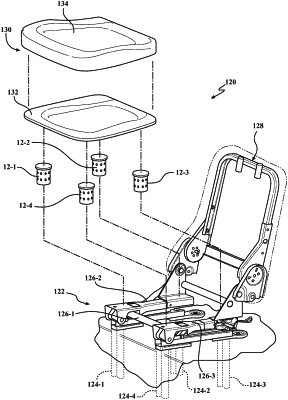| CPC B60N 2/502 (2013.01) [F16F 3/12 (2013.01); F16F 15/085 (2013.01); F16F 2224/025 (2013.01); F16F 2226/042 (2013.01); F16F 2226/045 (2013.01); F16F 2228/063 (2013.01); F16F 2230/36 (2013.01); F16F 2234/04 (2013.01)] | 13 Claims |

|
1. A vehicle seat assembly comprising:
a seat frame;
a seat pan; and
a plurality of vibration isolators interposed between the seat frame and the seat pan for limiting transmission of vibrations from the seat frame to the seat pan, each vibration isolator including:
a flexible housing including at least one wall defining an interior of the housing; and
an arrangement of conical disc spring members positioned in the interior and structured so that the vibration isolator provides a quasi-zero/negative stiffness response when a force applied to the isolator is within a predetermined range.
|